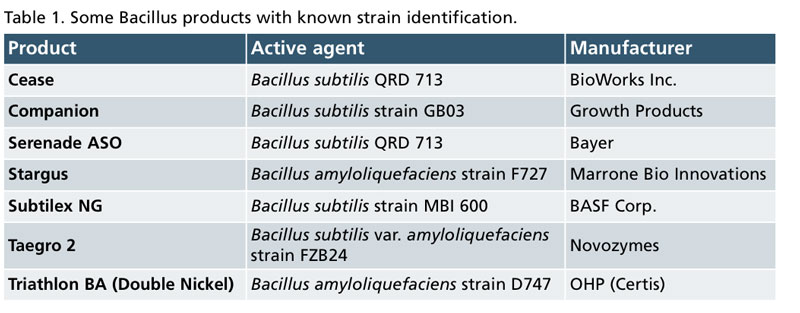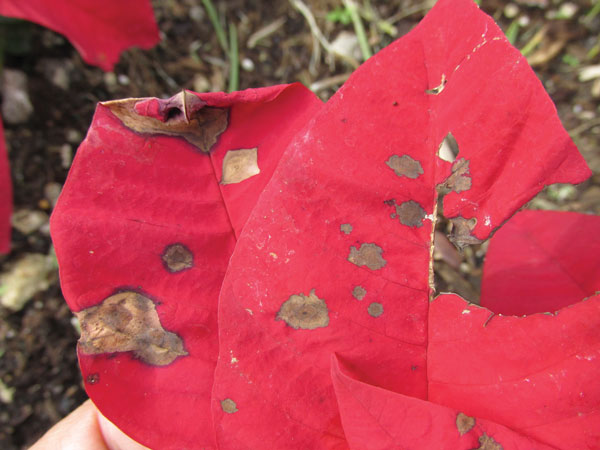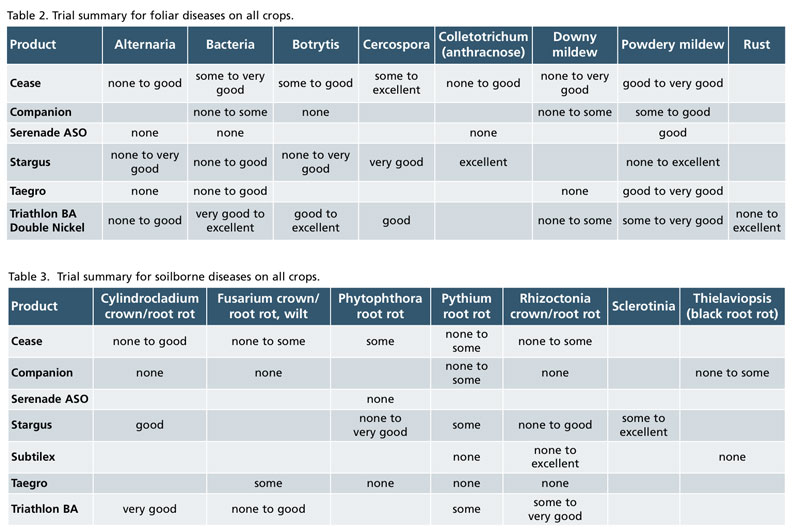3/1/2020
Bacillus-based Biopesticides
A. R. Chase
One of the first effective biological control agents that was registered for foliar diseases on ornamentals for disease control was discovered by Agraquest in California in the late 1990s and registered around 2005. It was originally called Rhapsody and is made from Bacillus subtilis QRD 713. We worked on it for years when we did trials in Northern California on ornamentals and we probably have more information on using Rhapsody/Cease for control of ornamental diseases than any of the other products created from strains of Bacillus subtilis or B. amyloliquefaciens. (There’s some debate about the naming of these bacteria, so I’ve listed simply what’s on each product’s label in Table 1.)

Rhapsody/Cease was one of the first biopesticides that was similar to conventional chemistry with respect to consistent positive results. Others have been registered as well, including the most recent product to enter our market, Stargus (Marrone Bio Innovations). Several others are also under development based on Bacillus species.
Table 1 lists some of these products, including their exact strain and manufacturers. Specific strain identification and strict product processes are critical. Each of the products I decided to include has a four-hour REI and is organic, making them user-friendly, especially for growers who produce edibles as well as ornamentals. However, not all Bacillus amyloliquefaciens/subtilis are the same. Buying a product with unknown or unidentified strain identification is like buying a pig in a poke—at least use EPA-registered products for reliable, consistent results.
How do these products work?
Are biological control products magic? Do we know the mechanisms that are acting to yield the positive results in disease control? Actually, a large effort has been underway for over 40 years. The Bacillus strains in the products I’m reviewing here share many of the same features.
 Pictured: Alternaria leaf spot on poinsettia.
Pictured: Alternaria leaf spot on poinsettia.
Antibiosis is the creation of anti-fungal metabolites. Some are created once the products are deployed (in the potting medium or soil), but most in our current products are made during production of the product itself. These include lipopeptides, enzymes, siderophores and salicylicates.
Competition through colonizing the rhizosphere (area closest to plant roots) also occurs in some cases. The space where a plant pathogen might live and invade the roots can be taken up by the Bacillus strain.
Many of, but not all, of the effective Bacillus products act on the plant. The defense systems can be activated, including causing production of plant chemistry (like gibberellins and cytokinens) that directly attacks the fungal or bacterial pathogen or enhances plant growth. Growth promotion, especially roots or improved seed germination, can result in the plant outgrowing the damaging effects of soilborne pathogenic fungi. In addition, reduced plant sensitivity to pathogen toxic metabolites, increased photosynthesis and delayed senescence also help control the negative effects of the disease.
Trial efficacy summary
Some of these products work better on foliar diseases (Cease and Triathlon BA), while others work better on soilborne diseases (Stargus). Some work better on bacterial leaf spots (Triathlon BA) than others. It would be hard to choose a single product to cover the range of diseases one might encounter in ornamental production.
Tables 2 and 3 summarize research trials with these Bacillus products on all crops. In some cases, the trials were primarily performed on edible crops, especially in Table 3. In others, a fair amount of the data is based on ornamentals. You can see that for some entries there’s a wide range of reactions.
 For instance, Triathlon BA (Double Nickel) has provided some to very good control of powdery mildew in research trials. This could be due to the fact that there are quite a few distinct genera of fungi that cause powdery mildew. Additionally, this work was performed on a variety of plant types under a variety of conditions. Sometimes a single entry rating is due to the fact that only one trial has been performed/reported. In all cases, many different researchers all over the U.S. have done some of the trials. As individuals working on very diverse crops, the trials necessarily would be conducted differently.
For instance, Triathlon BA (Double Nickel) has provided some to very good control of powdery mildew in research trials. This could be due to the fact that there are quite a few distinct genera of fungi that cause powdery mildew. Additionally, this work was performed on a variety of plant types under a variety of conditions. Sometimes a single entry rating is due to the fact that only one trial has been performed/reported. In all cases, many different researchers all over the U.S. have done some of the trials. As individuals working on very diverse crops, the trials necessarily would be conducted differently.
The fact that these are living organisms makes their full benefits dependent on more factors than use of a conventional fungicide or bactericide. It’s easier to affect a living organism with pH, salinity, temperature or even storage of the product. Thus, some of the negative results could be due to poor storage conditions alone.
Finally, these products can be very effective in a rotation with other biopesticides or conventional products. You can check manufacturer websites for compatibility of their Bacillus product with other effective choices for specific crops or diseases. Read the labels carefully—they usually include critical information on successful use of the product. GT
A. R. Chase is a plant pathologist and president of Chase Agricultural Consulting, LLC in Cottonwood, Arizona. She can be reached at archase@chaseresearch.net.